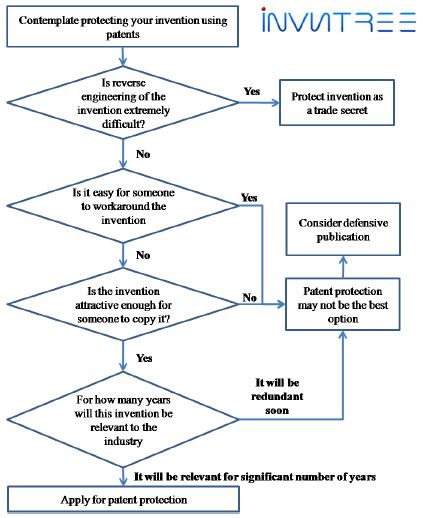Tag Archives: trade secret
Protecting an invention – A discussion on patents and trade secrets

Patents and trade secrets are intellectual property intended to protect inventions, using different approaches. “Patent” gives one right to exclude others from making, selling, using or importing a claimed product or process, in exchange of fully public disclosure of your invention. In lieu, “trade secret”, a self-explanatory term pertains to information, used in business (“trade”), that is not supposed to be known to the public or others in the industry (“secret”). Trade secrets covers valuable and secret information from formula, process to business information, which derive its commercial value from being kept secret and company’s reasonable efforts in keeping trade secret as “secret”. Google search algorithm makes a good example for a trade secret. The same information can be protected under a patent as well as trade secrets. The conundrum arises while making the choice between patent and trade secrets. When facing such a confusion, one must ask oneself whether invention is patentable at all? Does it meet legal requirements of novelty, non-obviousness and usefulness to be granted a patent, or not?
The paramount point of trade secrets is that the information pertaining is not supposed to be disclosed in general public. A well-kept secret could theoretically last forever, but there is a risk. Unlike with the patents, it is perfectly legal to reverse engineer and reproduce a trade secret. The non-disclosure requirement of the trade secrets in the public gives its holder the advantage of earning an economic advantage from it. However, it is not mandatory to keep the information a secret for a lifetime. When the trade secret loses it economic value or protection, it can be made accessible to public. Trade secrets protect owner’s secret from theft, by helping the trade secret owner to keep the information a secret, making it highly confidential information. Trade secrets can be patented by its owners at that point of time, when it is no longer in a need of being kept confidential. Patents, in contrast, can only be protected through public disclosure. Patent right is granted to its inventors under the Patent Act, 1970, in order to disclose their invention to the public in exchange for certain rights under the Patent Act. In fact, a patent will be invalidated if the inventor refrains from describing important details. Patents tend to protect the broad concept, while trade secrets can be used to protect details of product or process.
When it comes to patenting technical innovations, there is a need for the innovation to satisfy the requirements of novelty, utility, inventive step and patentable subject matter and commercial usage. However, unlike patents, trade secrets have no such specified criteria and there is no such examination process to test trade secrets. In case of patents, one of the biggest hurdle is the “subject matter eligibility”. The Act lists down certain subject matter that are not patentable subject matter, whereas no such inhibition with trade secrets. A trade secret can relate to anything, provided the owner keeps it as a secret, tending to offer some competitive edge and economic value. Claims in patents define patent protection, however in trade secret there is no such drafting needs. The underlying need of the patent system is for the patent owner to disclose the invention in the patent application, which opposes the requirements of trade secret protection. Even if an infringer independently develops the patented invention, this will not provide any defense for patent infringement. This issue does not apply for trade secrets. The owner of trade secret is powerless to prevent a competitor who chooses to reproduce a product or process that is protected by trade secret by reverse engineering. Hence, trade secret protection is useful against “unfair” users, whereas enforcing patent protection is based on distinct principles of claim infringement.
When it comes to commercialization of invention, the licensing of patented technology is much easier. The technology being licensed is defined precisely and license terms can be set out easily in a license agreement. In case of trade secrets, licensee needs to be satisfied that he/she is receiving a genuine trade secret, not something from public domain, hence there is no clear definition of trade secrets agreement. With respect to licensor’s perspective, any licensee may become a source of “leakage” of the trade secret. Hence, maintain the confidentiality of the trade secret is challenging for the licensee as well as the licensor.
Patents are granted for a tenure of 20 years by Indian Patent Act, 1970. After the expiry of a patent, anyone can commercially exploit the invention. The public might use the inventions for its benefit and the patent holder might not have a right over it anymore. In such cases, trade secrets are way better option than patents, since the term period is never-ending. There is no limitation period for trade secrets, since trade secrets remain confidential until it is transferred to someone. Patents protect the new and innovative inventions of inventors and patent rights ascertains the inventors the protection from other competitors in the market, offers security to inventors and motivates them for more useful innovations. In lieu, trade secrets protect information that doesn’t require to be disclosed to government. Hence, level of protection involved in trade secrets is comparatively less than that of patents. It is tedious to enforce protection of trade secrets as compared to patents.
In addition, the process of getting a patent grant takes time of approximately 3-4 years from the day of filing the patent application. The patent owner can reap the benefits of the patent only after the patent is granted before going through substantial examination and prosecution procedures which typically takes about 3-4 years. Such long time periods serves against the interest of the patent applicant as any other competitor may come up with the similar invention in this time period. However, trade secrets are beneficial in these cases. Trade secrets do not take much time, since after the acknowledgement of trade secrets and maintenance of internal procedures, it becomes a trade secret and gets protection.
Further, the expenses involved in patents are generally more compared to trade secrets. Patents require application fees, filing fees, patent renewal fee so on and so forth till the patent term. The cost may vary from jurisdiction to jurisdiction. In lieu, trade secrets is fairly inexpensive and it primarily includes administration cost for internal processes. Typically, trade secret just requires cost required to maintain its security, giving trade secrets an edge over the patent.
One significant threat to the popularity of trade secrets is the digitisation. With the ongoing data leak, hacking and so on, trade secrets have become more vulnerable than before considering that the onus of protecting the trade secret is on the owner. It is clear from the foregoing, it is clear the patents and trade secrets offer distinct set of advantages. One must use a pragmatic approach before choosing between patents and trade secrets. Ideally, protecting an invention using a combination patents and trade secrets may help one reap the maximum benefits out of them.
Please feel free check our services page to find out if we can cater to your requirements. You can also contact us to explore the option of working together.
Best regards – Team InvnTree
This work is licensed under a Creative Commons Attribution-Non Commercial 3.0 Unported License
Are patents always the best way to protect inventions?
To answer this question, let us first look at the bright side of patent. If you have a patent granted from your invention, it gives you the rights to exclude others from commercializing your patented technology for 20 years in the country in which it is granted. In other words, it means, you enjoy monopoly over the patented technology for 20 years in the country in which it is granted.
- On an average, it takes ~47 months (identified using a sample of 3191 US patents granted in the year 2011) from the date of filing a patent application to get a patent granted. Patenting is a time consuming process.
- Patents are territorial. This means, you will have to file patent applications in each country in which you want to protect your invention.
- You will have to pay a statutory fee to the patent office in each country you file a patent application. Additionally, you will also have to pay the patent consultant who helps you with filing the patent application in the respective country (we once received a quote of $2000 from a Japanese attorney for filing a patent application in Japan). In a nutshell, patenting is an expensive process.
Irrespective of all these hurdles, individuals and companies file for patents. In certain circumstances, it makes perfect sense to protect your inventions using patents. However, in my opinion, you should ask yourself some questions before you decide to protect your invention using patents.
- How easily can my invention be reverse engineered?
- How easy is it for someone to work around the invention and achieve the advantages provided by the invention?
- Is the invention attractive enough for someone to copy it?
- For how many years will this invention be relevant to the industry?

 Follow
Follow


